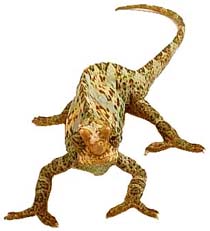DK Nature: Animals
Animals are grouped into two main types—vertebrates, with an inner skeleton, including a backbone, and invertebrates, without a backbone. As many as ten million species (different kinds) of animals—all with their own modes of BEHAVIOR—live on Earth.

A chameleon is camouflaged to blend in with its surroundings and moves around slowly to avoid detection by its predators and prey. To feed, the chameleon shoots out its tongue at a lightning-fast speed to hit insects before they have time to react.
All animals have bodies made up of many different cells and eat other organisms to survive. Unlike plants or fungi, which are rooted in one place, animals move around to find food, escape from enemies, and find a mate. Almost all animals breathe oxygen, either from the air or from water.
The world’s fastest animal is the peregrine falcon, which can exceed 125 mph (200 km/h) when diving through the air after prey. The fastest powered flight is that of the spine-tailed swift, at up to 105 mph (170 km/h). The quickest animal in water is the sailfish, which can swim at up to 68 mph (109 km/h).
Warm-blooded animals are those that generate their own body heat from food. Birds and mammals are warm-blooded. All other animals, including fish, reptiles, amphibians, and insects, are cold-blooded. Their body temperatures rise and fall with the temperature of their surroundings. These animals are less active in cold weather but require less food.
Some animals grow to enormous sizes. The world’s biggest animal, the blue whale, may reach 90 ft (27 m) long and weigh almost 165 tons (150 metric tons). On the other hand, some animals are too small to be seen with the naked eye. The world’s tiniest animals are creatures called mesozoans. They consist of fewer than 50 cells and measure less than 1/50 in (0.5 mm) long.
In order to survive, all animals must eat and avoid being eaten. They are also driven to reproduce so their species does not die out. Most animal behavior is geared to these basic goals. Some behavior is learned; the rest is controlled by instinct.
Animals behave in many different ways to escape danger. Some are camouflaged to blend in with their surroundings. Behavior such as staying still completes their disguise. Some species defend themselves with more complex behavior, such as pretending to be injured or dead. Hedgehogs and armadillos roll into a ball to ward off predators.
Instinct plays a major part in the behavior of animals, especially animals that are not reared by their parents. For example, when danger threatens, snails instinctively withdraw inside their shells. Animals also learn by trial and error, repeating actions that are productive and abandoning ones that are not.
All animals follow regular cycles to help them survive. Many creatures are active by day, when their senses work best. Others come out at night to avoid predators, or take advantage of feeding opportunities. Most animals also follow yearly cycles, usually bearing young when food is abundant.
